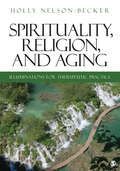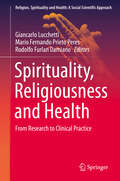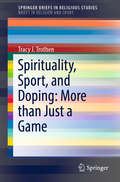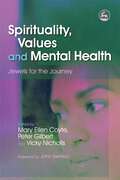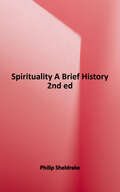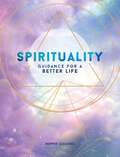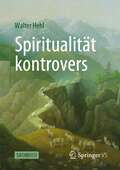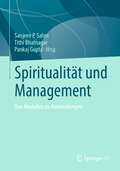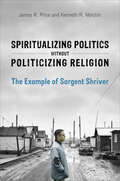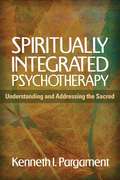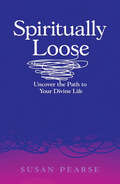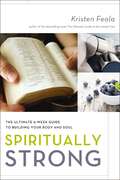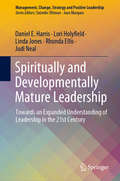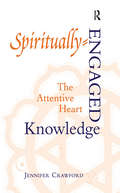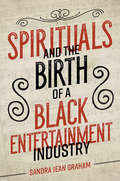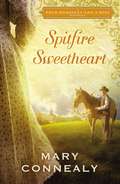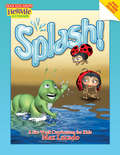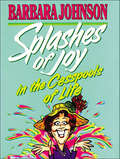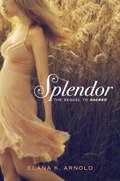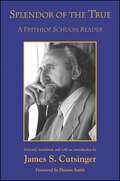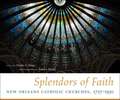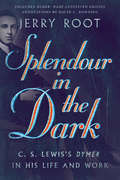- Table View
- List View
Spirituality, Religion, and Aging: Illuminations for Therapeutic Practice
by Holly B. Nelson-BeckerThis highly integrative book was written for students, professionals in aging, religious leaders, and older adults themselves. Readers will gain the knowledge and skills they need to assess, engage, and address the spiritual and religious needs of older persons. Taking a fresh approach that breaks new ground in the field, the author discusses eight major world religions and covers values and ethics, theories, interventions, health and caregiving, depression and anxiety, dementia, and the end of life. Meditations and exercises throughout the book allow readers to expand and explore their personal understanding of spirituality. Referencing the latest research, the book includes assessments and skill-based tools designed to help practitioners enhance the mental health of older people.
Spirituality, Religion, and Aging: Illuminations for Therapeutic Practice
by Holly B. Nelson-BeckerThis highly integrative book was written for students, professionals in aging, religious leaders, and older adults themselves. Readers will gain the knowledge and skills they need to assess, engage, and address the spiritual and religious needs of older persons. Taking a fresh approach that breaks new ground in the field, the author discusses eight major world religions and covers values and ethics, theories, interventions, health and caregiving, depression and anxiety, dementia, and the end of life. Meditations and exercises throughout the book allow readers to expand and explore their personal understanding of spirituality. Referencing the latest research, the book includes assessments and skill-based tools designed to help practitioners enhance the mental health of older people.
Spirituality, Religion, and Cognitive-Behavioral Therapy: A Guide for Clinicians
by David H. RosmarinSpirituality and religion are powerful forces in many people's lives, yet they are usually relegated to the periphery of cognitive-behavioral therapy (CBT) research and practice. This highly practical, nonsectarian book describes how to identify and work with psychologically relevant facets of spirituality in the context of evidence-based treatment. David H. Rosmarin draws on cutting-edge theory and research to provide clear guidelines for conceptualizing positive and negative aspects of spirituality pertaining to common clinical concerns. Concrete examples throughout the book illustrate collaborative ways to harness spiritual beliefs and practices to help bring about cognitive, behavioral, and affective change. Four reproducible handouts can be downloaded and printed in a convenient 8 1/2" x 11" size.
Spirituality, Religiousness and Health: From Research to Clinical Practice (Religion, Spirituality and Health: A Social Scientific Approach #4)
by Giancarlo Lucchetti Mario Fernando Prieto Peres Rodolfo Furlan DamianoThis book provides an overview of the research on spirituality, religiousness and health, including the most important studies, conceptualization, instruments for measurement, types of studies, challenges, and criticisms. It covers essential information on the influence of spirituality and religiousness (S/R) in mental and physical health, and provides guidance for its use in clinical practice. The book discusses the clinical implications of the research findings, including ethical issues, medical/health education, how to take a spiritual history, and challenges in addressing these issues, all based on studies showing the results of incorporating S/R in clinical practice. It contains case reports to facilitate learning, and suggests educational strategies to facilitate teaching S/R to health professionals and students.
Spirituality, Sport, and Doping: More than Just a Game (SpringerBriefs in Religious Studies)
by Tracy J. TrothenThis book explores the deeper meaning of sports. Drawing on contemporary research, the author makes a strong case for why we should see sport not only in terms of religion but--more importantly-as a possible location for spiritual meaning. Taking this a step farther, she considers how gene editing, robotics, and other biomedical technological enhancements affect not only sports performances but experiences of sport as sacred. In addition, the author explores what difference it might make to the enhancement debate if sports’ spirituality is taken seriously. The author is not afraid to explore the issue in all its complexity. Yet, the argument she presents is both meaningful and accessible. This investigation applies insights from Christian theology, applied ethics, psychology, and sports studies. From lightweight tennis racquets to anabolic steroids, athletes have long used technology and science to improve their performances. But, until now, no one has asked how biomedical technological enhancements might affect the undervalued spiritual dimension of sport. This book presents rich insights into the connection between sports, spirituality, and human enhancement technologies. It will appeal to researchers, athletes and sports followers, and undergraduate and graduate students in ethics, sport, religion or theology.
Spirituality, Values and Mental Health: Jewels for the Journey
by David Mitchell Andrew Powell Brian Thorne John Swinton Neil Thompson Sarah Carr Peter Gilbert Nigel Mills Azim Kidwai John Foskett Suman Fernando Fozia Sarwar Premila Trevedi Choman Hardi Vicky Nicholls Peter Bates Fatima Kassam Arthur Hawes Cameron Langlands Veronica Dewan Ju Blencowe Julia Head Tom Gordon Frances Basset B Spalek Anne Roberts Paul Grey Mark Bones Ali Jan Haider Barbara Pointon Mary Ellen Coyte Kim Woodbridge Wendy Edwards Christopher Newell Chris Mackenna Abina Parshad-Griffin Thurstine Basset Sarajane Aris Luftha Meah Paul Chapple Bill K. W. M. FulfordSpirituality, religious belief and inclusive faith communities are important for mental well being but mental health practitioners have few guidelines for acknowledging these issues when working with service users. Spirituality, Values and Mental Health gathers together personal and professional contributions from mental health professionals, carers and mental health service users and survivors. It addresses the stigma that can surround both mental health and spirituality and explores the place of the spiritual in mental health care, teasing out its implications for research, education, training and good practice. This book is a welcome source of ideas and common-sense that is essential reading for mental health practitioners, carers and service users, chaplains, faith leaders, faith communities, as well as students and professionals working in the field of spirituality and mental health.
Spirituality: A Brief History
by Philip SheldrakeEngagingly written by one of the world's leading scholars in this field, this comprehensively revised edition tells the story of Christian spirituality from its origins in the New Testament right up to the present day. - Charts the main figures, ideas, images, and historical periods, showing how and why spirituality has changed and developed over the centuries - Includes new chapters on the nature and meaning of spirituality, and on spirituality in the 21st century; and an account of the development and main features of devotional spirituality - Provides new coverage of Christian spirituality's relationship to other faiths throughout history, and their influence and impact on Christian beliefs and practices - Features expanded sections on mysticism, its relationship to spirituality, the key mystical figures, and the development of ideas of 'the mystical' - Explores the interplay between culture, geography, and spirituality, taking a global perspective by tracing spiritual developments across continents.
Spirituality: Guidance for a Better Life
by Sophie GoldingConnect to your inner self and the world around you and enjoy a new sense of peace and happiness. This stunning book will help you along your own spiritual journey, by introducing you to traditions, philosophies and practices which have the power to open your heart and broaden your mind. Along with tips on how to practise spirituality in your everyday life, this book provides the stepping stones to a more fulfilling life.
Spirituality: Guidance for a Better Life
by Sophie GoldingConnect to your inner self and the world around you and enjoy a new sense of peace and happiness. This stunning book will help you along your own spiritual journey, by introducing you to traditions, philosophies and practices which have the power to open your heart and broaden your mind. Along with tips on how to practise spirituality in your everyday life, this book provides the stepping stones to a more fulfilling life.
Spiritualität kontrovers
by Walter HehlDas Buch versucht einen fairen Blick auf Spiritualität und Spirituelles aus Sicht der Physik und der modernen Geistesauffassung. So vieles soll spirituell sein, aber was ist es wirklich? Es gibt Aberglauben, Betrug und Illusionen einerseits und moderne Wissenschaft andererseits. Die Wissenschaft zeigt, was Geist ist, dass es unendlich Großes und unendlich Kleines gibt, dass wir so Vieles berechnen können - aber es bleibt das Mysteriöse. Manches in der Wissenschaft ist unmittelbar spirituell, etwa die Figuren von Lichtenberg und Chladni im 18. Jahrhundert und die Kirlian-Fotographie und Tesla-Kugeln heute. Vieles verstehen wir nur oberflächlich. Wenn es der Computer versteht und wir nicht, können wir nicht zufrieden sein. Die Grenzen des Wissens sind weit nach außen verschoben, aber wir sind klein geblieben. Wir stoßen an Grenzen und begegnen Spirituellem: im Unendlichen, im Unausweichlichen und im Unfassbaren. Diese Grenzen sollten uns demütig machen. Die moderne Wissenschaft zeigt diese Grenzen auf. Die Spiritualität ist dann eher die Erfahrung des Mysteriösen des Physikers Albert Einstein. Es gibt Spirituelles, etwa wie eh und je den Anblick des Sternenhimmels oder des Ozeans. Auch heute sind Orte wie Stonehenge spirituelle Plätze oder Kraftörter. Der Magnetismus im Elektrofahrzeug ist so spirituell wie im Magnetstein der Antike. Besonders spirituell ist die Verbindung der Natur mit der Mathematik.
Spiritualität und Management: Von Modellen zu Anwendungen
by Pankaj Gupta Sanjeev P. Sahni Tithi BhatnagarDieses Buch erörtert die Bedeutung der Integration von Spiritualität aus vielfältigen Wissenshintergründen, um in der alltäglichen Anwendung wirksam zu sein. Indem es weltweit führende Experten auf diesem Gebiet zusammenbringt, bietet das Buch einen umfassenden Überblick über verschiedene Themen, Modelle, Ansätze und Komplexitäten von Spiritualität und Management. Die Kapitel des Buches befassen sich mit Überlegungen zur Weisheit aus der Bhagavadgita und dem Buddhismus, dem Einfluss von Spiritualität auf gute Führung, Lebensqualität, die Integration von Ethik, menschlichen Werten und Glück, Meditation sowie der Verknüpfung von Spiritualität und Management und deren Auswirkungen auf Führung und Arbeitsumgebung. Ein anregender Lesestoff für Wissenschaftler, Studierende und Entscheidungsträger, bietet dieses Buch eine indische Perspektive auf das Management von Spiritualität am Arbeitsplatz. In der post-COVID-19-Situation gewinnt das Buch noch mehr an Relevanz, da es sich auf die ganzheitliche Entwicklung von Menschen und Organisationen konzentriert.
Spiritualizing Politics without Politicizing Religion: The Example of Sargent Shriver
by Kenneth R. Melchin James R. PriceThe clash of religion and politics has been a steady source of polarization in North America. In order to think wisely and constructively about the spiritual dimension of our political life, there is need for an approach that can both maintain the diversity of belief and foster values founded on the principles of religion. In Spiritualizing Politics without Politicizing Religion, James R. Price and Kenneth R. Melchin provide a possible framework, approaching issues in politics via a profile of Sargent Shriver (1915-2011), an American diplomat, politician, and a driving force behind the creation of the Peace Corps. Focusing on the speeches Shriver delivered in the course of his work to advance civil rights and build world peace, Price and Melchin highlight the spiritual component of his efforts to improve institutional structures and solve social problems. They contextualize Shriver’s approach by contrasting it with contemporary, landmark decisions of the U.S Supreme Court on the role of religion in politics. In doing so, Spiritualizing Politics without Politicizing Religion explains that navigating the relationship of religion and politics requires attending to both the religious diversity that politics must guard and the religious involvements that politics needs to do its work.
Spiritually Integrated Psychotherapy
by Kenneth PargamentFrom a leading researcher and practitioner, this volume provides an innovative framework for understanding the role of spirituality in people's lives and its relevance to the work done in psychotherapy. It offers fresh, practical ideas for creating a spiritual dialogue with clients, assessing spirituality as a part of their problems and solutions, and helping them draw on spiritual resources in times of stress. Written from a nonsectarian perspective, the book encompasses both traditional and nontraditional forms of spirituality. It is grounded in current findings from psychotherapy research and the psychology of religion, and includes a wealth of evocative case material.
Spiritually Loose: Uncover the Path to Your Divine Life
by Susan PearseYour divine life is as individual as your fingerprints: your spiritual path is unique.Spirituality isn&’t always found in organised religion, temples, or gurus. It doesn&’t need to be outsourced. Your divine life lies within, all you need to do is listen to your inner voice!Spiritually Loose shows how one woman replaced soul-destroying expectations and obligations with connection, meaning and possibilities.Susan&’s journey included raves in Ibiza, jazz bars in New York; lectures on quantum physics in Italy, philosophy classes in Australia; traditional hula dancing in Hawaii and qualifying as a Kundalini yoga teacher in Spain. Instead of finding answers, she found rules. Instead of joy, she found judgement. However, once she began looking inward, she tuned into her inner voice of love, acceptance, and joy.Tuning into your inner voice is an antidote for emptiness, regret and disappointment. It&’s a powerful reminder that it&’s ok to be spiritual and loose, humble and confident, reverent and cheeky, patient and intolerant, brave and vulnerable, deep and superficial all at once. Above all, it&’s a reminder that it&’s perfect just to be you.
Spiritually Strong: The Ultimate 6-Week Guide to Building Your Body and Soul
by Kristen FeolaSpiritually Strong is a six-week program designed to help you get in better shape spiritually and physically. As Timothy says, “For physical training is of some value, but godliness has value for all things, holding promise for both the present life and the life to come” (4:8). This book teaches you how to train yourself in godliness through the implementation of six disciplines—Bible study, prayer, fasting, healthy living, financial stewardship, and serving others. By exercising your spiritual core on a daily basis, you will learn to: Study the Bible and understand what God is saying to you. Pray with power. Incorporate periodic fasting into your life. Honor God with your body through nutritious eating and exercise. Practice good stewardship of the resources God has given you. Serve others in humility as an outward demonstration of God’s love. As you learn to submit to God in each of these areas of your life, you’ll discover the joy that accompanies self-discipline. Your daily steps of obedience will translate into giant strides in your walk with the Lord.
Spiritually and Developmentally Mature Leadership: Towards an Expanded Understanding of Leadership in the 21st Century (Management, Change, Strategy and Positive Leadership)
by Linda Jones Judi Neal Daniel E. Harris Lori Holyfield Rhonda EllisThe book goes beyond theory to offer tools and suggestions for developing emerging leaders. Inspired by the pioneering work of leadership scholar Andre Delbecq, this book points towards an expanded model of leadership that incorporates an active inner life, and posits that such fully human models of leadership will be essential to meet the profound challenges of the 21st Century. Without presuming to provide definitive answers, the text explores central questions such as: What is the added value of spiritual maturity to leadership? Would the integration of mature spirituality with well-developed intellectual and emotional capacities produce more beneficial leadership outcomes for organizations and individuals? What would a spiritually and developmentally mature emerging leader look like in 10 to 20 years? How do we prepare emerging leaders for the challenges they may face; and how do we model spiritually and developmentally mature leadership in ways that resonate with them?Professor Andre Delbecq (1936-2016) of the University of Santa Clara created the heuristic of “spiritually and developmentally mature leaders” to encapsulate his observation that outstanding leaders often seemed to draw strength and wisdom from sources that are not typically studied or taught in leadership courses. Thirty scholars and practitioners accepted Delbecq’s heuristic as the starting point to explore spiritual components of leadership that do not easily lend themselves to quantification or clear causal links. The analysis of their disciplined engagement with the heuristic forms the foundation of an exploratory, fully human understanding of leadership. This analysis is supported by literature reviews, including an overview of Andre Delbecq’s relevant work. Ultimately, the authors call for further collaboration across disciplines and between research and practice to build on the conceptual constructs offered here, and, especially, to create pedagogies for the training of spiritually and developmentally mature leaders
Spiritually-Engaged Knowledge: The Attentive Heart
by Jennifer CrawfordIn a supposedly ’global age,’ which not everyone accepts, the late Dr Jennifer Crawford has brought together a range of disciplines in her creation of a unified, sensitive ’way of knowing’ for the global era. Drawing upon her academic and lived experience in philosophy, environmental science, social work and feminism, together with a deep spiritual commitment, Jennifer Crawford has deftly woven together complex ideas in her reconceptualisation of global justice. Spiritually-Engaged Knowledge: The Attentive Heart is framed within the author’s troubling encounters in India recounted in the Prologue and Epilogue. These transformative experiences inspired her multi-disciplinary exploration of justice, which took her beyond the boundaries of Western epistemology. Locating the global, the author defines what it is to be a member of a global community in which cross-cultural encounters bring forth the possibility of new genre of knowledge. Crawford situates her argument within contemporary philiosohpical contexts, drawing upon postmodern discourse, globalisation theory and the realisation of shared horizon for all human knowledge, which offers up a potential for ’knowing globally’. Crawford takes the reader through feminist theory, the ethic of care, the craft of ’othering’, surrender to the ’other’ and to our relationship with the earth which, she argues, can be reconfigured into an ethically-based way of knowing. Drawing on a range of belief systems, including Australian Aboriginal spirituality, Christianity, Buddhism, Hinduism, metaphysics and Western philosophy, Crawford rebuilds an inclusive, compassionate, redefinition of care for the new millennium, which she calls spiritually-engaged knowledge.
Spirituals and the Birth of a Black Entertainment Industry (Music in American Life #433)
by Sandra Jean GrahamSpirituals performed by jubilee troupes became a sensation in post-Civil War America. First brought to the stage by choral ensembles like the Fisk Jubilee Singers, spirituals anchored a wide range of late nineteenth-century entertainments, including minstrelsy, variety, and plays by both black and white companies. In the first book-length treatment of postbellum spirituals in theatrical entertainments, Sandra Jean Graham mines a trove of resources to chart the spiritual's journey from the private lives of slaves to the concert stage. Graham navigates the conflicting agendas of those who, in adapting spirituals for their own ends, sold conceptions of racial identity to their patrons. In so doing they lay the foundation for a black entertainment industry whose artistic, financial, and cultural practices extended into the twentieth century. A companion website contains jubilee troupe personnel, recordings, and profiles of 85 jubilee groups. Please go to: http://www.press.uillinois.edu/books/graham/spirituals/
Spitfire Sweetheart
by Mary ConnealyIt's 1885 and five preachers sit around a campfire out West, trading stories of unlikely couples they've seen God bring together. This is one of those stories . . .She's reckless spitfire and, thanks to her, he's a wreck . . .Maisy Place didn't mean for Ryan to come to any harm. She was just looking for a quiet space to nurse her wounded pride after he'd hurt her feelings. But then she wandered onto Ryan's property and into a heap of trouble. Ryan rescued her from a charging grizzly only to find himself with serious breaks and bruises.Maisy sheepishly agrees when her father insists that she nurse the wounded Ryan back to health as penance. And when his ranch hand leaves him high-and-dry just weeks before a critical cattle sale, Maisy steps in to help. Her cowboy-like ways that have always driven him crazy may ultimately prove to be his salvation . . . and pave the way to their romance."Nobody tugs a heart or a smile quite like Mary Connealy . . . she is a master storyteller who leaves her readers both breathless . . . and breathless for more." --Julie Lessman, award-winning author of The Daughters of Boston (on "Winter Wedding Bells" in A Bride for All Seasons)"Christian novelist Connealy writes to tickle the funny bone and tease heartstrings." --Publishers Weekly
Splash!: A Kid's Curriculum Based on Max Lucado's Come Thirsty
by Max LucadoCome along with Max Lucado's fun-filled Hermie and Friends, and dive in and discover God's gifts for you. Using six great themes of the Bible and based off of the popular trade book, Come Thirsty, Splash! is a comprehensive lesson plan for 3-8 year olds. As the children go to the W-E-L-L, they will learn of Jesus' Work, Energy, Lordship, and Love! The six-week children's curriculum is teacher-friendly, fully reproducible, and easily adaptable to several age levels. The exciting features include: Bible stories Puppet skits Craft ideas Drama suggestions Activity sheets Hermie and Wormie coloring pages Object lessons Memory verse games and songs Enrichment activities
Splashes of Joy in the Cesspools of Life
by Barbara JohnsonFor when you need bliss now, take a quick jump into these puddles of goodness—from the bestselling author of Living Somewhere Between Estrogen and Death.This mini book offers invigorating spurts of encouragement and gentle reminders to splatter joy into the lives of yourself and others. “Almost everyone needs a splash of joy to get through the mess,” Barbara Johnson says. And that’s what you get in this collection of giggles and guidance to help you get “cleaned off and sweetened up—refreshed and ready to go again!”
Splendor
by Elana K. ArnoldSplendor, the stunning sequel to Sacred, is a story about changing friendships, family, romance, passion, the study of Kabbalah, and self-discovery. Sometimes the answers we seek aren't ours to find. . . . Scarlett loves her boyfriend, the dashing, mysterious Will Cohen. But now he's gone east for college, and Scarlett is stuck home on Catalina Island. Senior year should be a breeze, but between dealing with her parents' separation and her wild best friend, Lily, things are off to a rocky start. And then there's Gunner. Dangerous, dark, ferociously attractive Gunner. Lily's potential boyfriend, Gunner . . . Scarlett distracts herself by spending time with her horse and delving into ecstatic mysticism, a way to practice Kabbalah. Through this practice, she hopes to learn to control her emotions, and begin to make sense of her place in the world. But Scarlett's world is increasingly unrecognizable. Are Lily and Scarlett becoming too different to stay friends? Is Will still the love of Scarlett's life, even though she has feelings for Gunner? Does being in love mean only being attracted to one person? The more Scarlett questions, the fewer answers there seem to be.
Splendor of the True: A Frithjof Schuon Reader (SUNY series in Western Esoteric Traditions)
by James S. CutsingerFrithjof Schuon (1907–1998), the leading figure in the perennialist school of comparative religious thought, remains one of the most provocative voices on religion. Bridging the divide between seeker and scholar, Schuon challenges the prevailing notion that religion should be studied with agnostic neutrality. He speaks to those who are looking for greater interfaith understanding and a deeper penetration to the esoteric heart of specific traditions, while turning the tables on an increasingly noisy chorus of skeptics.In Splendor of the True, James S. Cutsinger selects essential writings that reflect the full range of Schuon's thought on religion and tradition, metaphysics and epistemology, human nature and destiny, sacred art and symbolism, and spirituality and contemplative method. In addition to Schuon's essays, the book includes a number of poems, artworks, and previously unpublished materials drawn from his letters, personal memoirs, and private texts for disciples. An introductory chapter provides a careful examination of Schuon as perennial philosopher, Sufi shaykh, and teacher of gnosis.
Splendors of Faith: New Orleans Catholic Churches, 1727-1930
by Charles E. Nolan Frank J. MetheA gumbo of French, Spanish, and American influences, the architecture of New Orleans has always reflected the city's strong Catholic roots. Indeed, St. Louis Cathedral across from Jackson Square stands as perhaps the most widely recognized face of New Orleans. The cathedral, though, is just one of many stunning churches that beautifully reflect the city's long and diverse Catholic heritage. Splendors of Faith showcases thirteen of these historic churches of exceptional architectural and artistic beauty, revealing scenic treasures that lie mostly beyond the well-worn tourist paths.The earliest of the thirteen, St. Louis Cathedral, traces its origin to 1727. The most recent, Immaculate Conception, was built in 1930 but modeled after its mid-nineteenth-century predecessor. The eleven other churches are Blessed Francis Xavier Seelos, Holy Name of Jesus, Mater Dolorosa, Our Lady of the Rosary, St. Anthony of Padua, St. Francis of Assisi, St. Joseph, St. Mary's Assumption, St. Patrick, St. Peter Claver, and St. Stephen.In image and word, photographer Frank J. Methe and historian Charles E. Nolan capture the splendor of these places of worship. Methe provides sumptuously detailed color photographs of the churches and their interior décor. Nolan offers enlightening commentary about each edifice, its congregation, and the rich variety of art forms assembled over the years: architecture, stained glass, statuary, mosaics, paintings, and more. New Orleans Catholics and their churches experienced dramatic change after Hurricane Katrina and the levee breaks. The buildings featured here, some of which suffered major damage in 2005, continue to serve as places of worship, bearing witness to a vibrant cultural component in one of the country's most beloved cities. Splendors of Faith takes readers inside these landmark churches and reveals their aesthetic and historical significance as never before.
Splendour in the Dark: C. S. Lewis's Dymer in His Life and Work (Hansen Lectureship Series)
by Jerry RootSeveral years before he converted to Christianity, C. S. Lewis published a narrative poem, Dymer, under the pseudonym Clive Hamilton. Later, of course, Lewis became well known for his beloved imaginative stories, such as The Chronicles of Narnia and Till We Have Faces, as well as his ability to defend and articulate the faith in works such as Mere Christianity. But what about his literary work before his conversion? In this fourth volume in the Hansen Lectureship Series, Jerry Root contends that Lewis's early poem Dymer can not only shed light on the development of Lewis's literary skills but also offer a glimpse of what was to come in his intellectual and spiritual growth—a "splendour in the dark," to borrow one of Lewis's own lines from the poem. Under Root's careful analysis, Dymer becomes a way to understand both Lewis's change of mind as well as the way in which each of us is led on a journey of faith. This volume also includes the complete text of Dymer with annotations from David C. Downing, co-director of the Marion E. Wade Center. The Hansen Lectureship series offers accessible and insightful reflections by Wheaton College faculty members upon the transformative work of the Wade Center authors.
